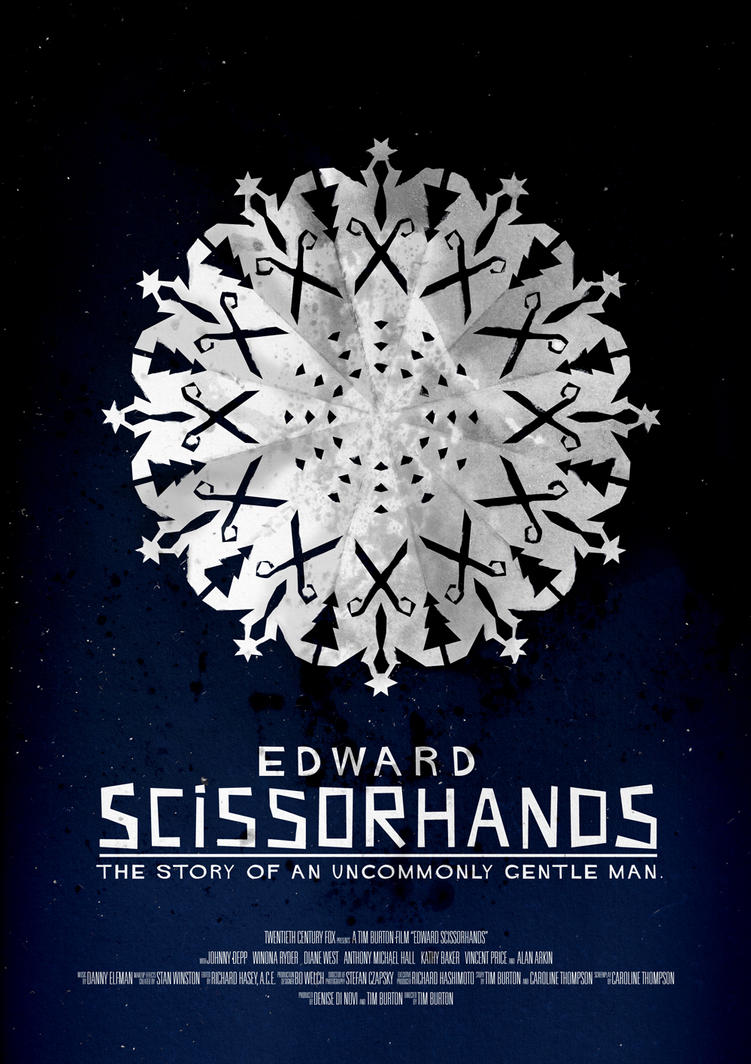Edward Scissorhands (1990)
Fig.1
In 1990 a picture that can only be described as a love letter to the classic campy horror/thriller films of the past, was created by a man who clearly had a taste for the bizarre and macabre. Edward Scissorhands (1990) was this love letter, another master piece directed by Tim Burton, no commonly regarded for his quirky yet, dark cinematic style, for example his reimagining of the batman series as a darker more serious story than the classic comedic one, which it has remained to this day. Edward Scissorhands Plot is a sort of hybrid between two iconic and classic cinema stories and tropes, the Frankenstein's monster idea, and the classic romance story of "Beauty & the Beast" (belle le bête link). This was achieved by taking the concept of a man created by science, who does not fit into the world and is feared because he is not understood, but unlike the Frankenstein's monster of before he is innocent and kind, and the trope of the monster who doesn't fit in falling in love with an evanescent beauty. There's this strange contrast as well where everyone who doesn't know Edward personally think he can only destroy but in fact he is a great artist and creator who actively attempts to express himself.
This contrast of what people this versus what the truth actually is carries on into the set design too. Throughout the film we are shown a overly idealistic concept of fifties/sixties suburbia, all the houses are more or less the same design, all owned by materialistic house wife's who all own similar things and dress in form with each other, as if there is a form of status quo to meet, all very fake. They seem harmless enough at first but evilly you find out they're are disloyal and malicious. The only real difference of there lifestyles is the colours of their houses and they're cars, as a small state of individuality. On the other end f the scale Edward lives in a completely in case gothic castle on a hill built directly next to this city for some reason, very looming and intimidating, but In fact there is nothing sinister going on inside, the old scientist before his death only had good intentions for his creation as far as we are shown "...gothic castle crouches on a mountaintop high above a storybook suburb, a goofy sitcom neighbourhood where all the houses are shades of pastels and all of the inhabitants seem to be emotional clones of the Jetsons." (Ebert, 1990).
Fig.2
Edward is initially discovered by Peg, the mother of the family Edward is taken into, after failing to sell her Avon product to her various friends and neighbours she decides to head to the old gothic castle for some reason and see if anyone there will buy her products. After walking through a garden of well kept bush statutes she enters the castle on her own accord, eventually discovering Edward at the top of the building, initially afraid of his shining claws, but she sees that he is in fact fearful and doesn't want her to run away from him, seeing his state she decides to take Edward in, realizing he has no one else. "Peg is alarmed at first by the flash of Edward's lethal blades. But her maternal instincts are soon aroused. Edward is a hazard, slicing gashes in his face every time he wipes away a stray of hair." (Travers, 1990).
After Edward enters the town he is soon seen as exciting and desirable, because of his uniqueness and outspoken difference to what the towns people consider normal,. His latent skills and overall kindness begin to shine out and he is soon the centre of attention in the town, going from continuing his garden foliage art, through dog grooming and eventually hair dressing, to the point where he is put forward for opening his own salon.
After moving in the Pegs family Edward soon meets her daughter, who Edward is immediately smitten with. At first she is intimidated and unfriendly with Edward, and her jock'ish boyfriend sees him as no immediate threat to him. But after a few encounters were she sees the real person Edward is beyond his appearance, and a botched robbery planned by her boyfriend, she realizes she loves Edward and not Biff. Resulting in her confessing and Edward finally experiencing love, but after a misunderstanding the entire town ends up against Edward and he flees back to his original castle, there he has a final confrontation with Biff after he hits and he is swiftly killed by Edward, realizing they cannot be together now Edward bids his farewell and she returns home, never to meet Edward again.
Fig.3
It can be said this story of a creative misfit having to live in a cookie cutter consumerist society and not fitting in because of that, is in fact a reflection of Burtons youth, and he is using Edward as a reflection of his experience "The Visual representation of suburban life is skill fully and imaginatively portrayed through the eyes of the outsider, of Edward and no doubt the eyes of self proclaimed odd-ball Burton Himself." (Horne, 2003).
Bibliography:
Ebert, R Edward Scissorhands http://www.rogerebert.com/reviews/edward-scissorhands-1990
Horne, D Edward Scissorhands http://www.close-upfilm.com/reviews/e/edwardscissorhands.htm
Travers, P Edward Scissorhands http://www.rollingstone.com/movies/reviews/edward-scissorhands-19901214
Illustration:







Hi Brad.... there doesn't appear to be anything here? No text, no images...?
ReplyDeleteFixed :)
DeleteAlso - can you 'de-centralise' the text layout?
ReplyDeleteon it !
DeleteHi Brad... a thoroughly engaging review, well done :)
ReplyDeleteJust a couple of points - make sure that you italicise your quotes, and not the reference after the quote. Also, be careful of your 'their' and ''they're' s...
And Kim's boyfriend was called Jim, not Biff!! (Was Biff not from Back to the future?)
You're right ! sorry I did actually fix this because i realised he was called Jim but my internet is so unreliable it didn't go through.
Delete